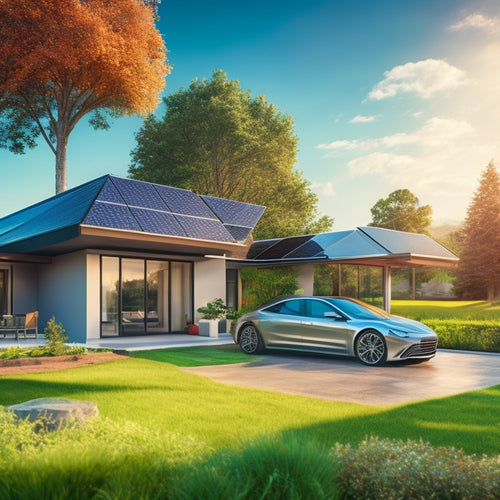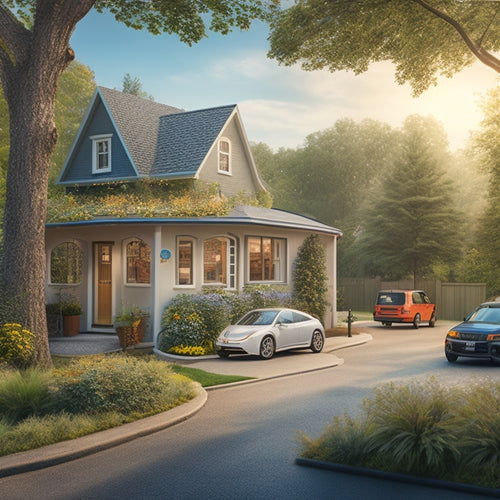
10 Steps to Residential Solar Setup
Share
You're about to initiate a thorough expedition to transform your home into a renewable energy powerhouse by setting up a residential solar system, which requires a detailed 10-step process to guarantee a seamless and cost-effective shift. Start by evaluating your energy needs, examining your roof's suitability, and determining the right number and type of solar panels for your home. Next, select a suitable mounting system, investigate energy storage options, and research local incentives to maximize your savings. Then, obtain necessary permits, install your solar panel system, and monitor and maintain it to guarantee peak performance. As you proceed, you'll uncover the complexities of each step, guiding you towards a successful and efficient residential solar setup.
Key Takeaways
- Assess energy needs by analyzing past energy bills, occupancy, and appliances to design a reliable solar system.
- Evaluate roof suitability considering orientation, shading, structural integrity, and local climate to ensure optimal performance.
- Determine the required number and type of solar panels based on energy consumption patterns, roof dimensions, and panel efficiency.
- Research local incentives, such as federal tax credits, state rebates, and property tax exemptions, to reduce upfront costs.
- Obtain necessary permits, including zoning approvals, environmental clearances, and building code compliance, before installation.
Assess Your Energy Needs
Your home's unique energy profile serves as the foundation for a well-designed residential solar setup. To accurately assess your energy needs, you'll need to evaluate your energy consumption patterns. This involves analyzing your past energy bills to identify peak usage periods, overall energy consumption, and power efficiency. By doing so, you'll determine the ideal system size and configuration required to meet your energy demands.
Take into account factors like the number of occupants, appliances, and lighting systems in your home. Each of these components contributes to your overall energy profile, influencing the type and capacity of solar panels needed.
You may also want to think about energy-efficient upgrades, such as LED lighting or energy-star appliances, to reduce your energy consumption and maximize the effectiveness of your solar setup. By understanding your energy needs, you can design a solar system that provides reliable power, reduces your reliance on the grid, and enhances your energy savings.
Evaluate Your Roof's Suitability
Evaluating your roof's suitability is a critical step in the residential solar setup process, as it directly impacts the system's performance, durability, and overall return on investment. You'll want to take into account factors that affect the system's energy efficiency and lifespan.
| Factor | Consideration | Impact |
|---|---|---|
| Roof Orientation | Ideal orientations: south-facing, 15-40° pitch | Best energy production |
| Shading Analysis | Identify obstructions: trees, buildings, vents | Reduced energy output |
| Structural Integrity | Roof's condition, material, and age | Supports system weight, withstands weather |
| Local Climate | Weather patterns, temperature extremes | Affects system performance, durability |
| Building Codes | Compliance with local regulations | Installation costs, permits required |
You should also research local building codes, homeowner associations' rules, and maintenance requirements to guarantee a smooth installation process. A suitable roof will lead to better energy efficiency, a longer system lifespan, and reduced installation costs.
Determine Solar Panel Quantity
You'll need to assess your energy needs to determine how many solar panels you require.
Calculate your average daily energy consumption in watt-hours to get an accurate estimate.
Assess Your Energy Needs
Energy efficiency is the linchpin of a successful residential solar setup, and it begins with accurately appraising your energy needs. To do this, you'll need to evaluate your energy consumption patterns. Start by reviewing your past utility bills to understand your average energy usage. Look for trends, such as peak usage during summer months or high energy consumption during the day.
Next, identify areas where you can reduce your energy consumption. Consider upgrading to energy-efficient appliances, installing LED lighting, and optimizing your thermostat settings. This will help you determine how much energy you'll need to generate with your solar panel system.
Be sure to account for any future energy needs, such as adding electric vehicles or powering a home office. Accurately appraising your energy needs will help you determine the right size for your solar panel system.
Calculate Panel Requirements
About 20-30 solar panels are typically needed for a standard residential solar setup, but the actual number depends on several factors, including your energy needs, roof size, and local building codes.
To determine the exact number of panels you'll need, you'll need to calculate your total energy requirements. Review your past energy bills to identify your energy consumption patterns, including peak usage hours and seasonal variations. This information will help you determine the total wattage required to power your home.
Next, consider the solar panel efficiency, which affects the amount of energy each panel can produce. More efficient panels will require less space, but may be more expensive.
You'll also need to factor in your roof's dimensions and orientation, as well as any local building codes or regulations that may impact your solar panel installation.
Choose a Solar Panel Type
Choosing the appropriate solar panel type is an essential step in your residential solar setup, as it greatly impacts the overall performance and cost of your system.
You'll need to evaluate the monocrystalline benefits, which include higher solar efficiency ratings and better low-light performance, although at a higher cost.
Polycrystalline panels, on the other hand, offer a lower cost per watt, but with slightly lower efficiency ratings.
Thin film advantages lie in their flexibility and lower production costs, making them a more environmentally friendly option.
When comparing costs, examine the brand reliability, warranty options, and installation considerations.
While higher-efficiency panels may cost more upfront, they can provide better long-term value.
Aesthetic preferences also play a role, as some panels are designed to blend in with your roof's appearance.
Ultimately, you'll need to weigh the pros and cons of each type to determine the best fit for your residential solar setup.
Select a Mounting System
When selecting a mounting system for your residential solar setup, you'll need to evaluate your roof type to determine the most suitable mounting option.
You'll want to take into account factors such as roof size, material, and pitch to guarantee a secure and efficient installation.
You'll also need to choose from various mounting hardware options, including rail-based, rail-less, and tracking systems, to optimize your solar panel performance.
Roof Type Assessment
As you prepare to install a residential solar setup, reviewing your roof type is crucial in selecting the right mounting system. The roof type evaluation involves contemplating factors such as roof materials, aesthetic considerations, and structural integrity.
Here are key factors to contemplate when reviewing your roof type:
-
Roof Materials: Different roof materials, such as asphalt shingles, metal, or tile, require specific mounting systems. Ascertain the mounting system is compatible with your roof material to prevent damage or leaks.
-
Aesthetic Considerations: Reflect on the visual appeal of the solar panel installation. Some mounting systems are designed to be more discreet, while others are more visible. Choose a system that fits your desired aesthetic.
-
Structural Integrity: Review your roof's structural integrity to verify it can support the weight of the solar panels and mounting system. Consult with a professional if you're unsure about your roof's condition.
Mounting Hardware Options
With your roof type assessed, you're now ready to select a mounting system that suits your residential solar setup.
You'll need to choose from a range of options, each with its own advantages and disadvantages. Fixed mounts are a cost-effective option, but they don't allow for adjustments. Adjustable mounts, on the other hand, enable you to change the angle of your solar panels to optimize energy production.
Ground mounts are ideal for homes with large yards, while solar racks and tilt mounts provide flexibility for roofs with obstacles. Flush mounts and pole mounts offer sleek, low-profile designs. Rail systems are a popular choice, offering a strong and versatile solution.
When selecting a mounting system, prioritize wind resistance and durability to guarantee your solar panels withstand harsh weather conditions. Additionally, consider eco-friendly materials that minimize environmental impact.
Plan Energy Storage Options
You need to plan energy storage options to guarantee a reliable and efficient residential solar setup.
With solar energy, you can't always control when the sun shines, so it's essential to store excess energy generated during the day for use during the night or on cloudy days.
To plan energy storage options, consider the following:
-
Battery Technologies: Research different battery types, such as lead-acid, lithium-ion, and flow batteries, to determine which one suits your energy needs and budget.
-
Energy Management: Decide on an energy management system that can monitor and control your energy usage, ensuring that your stored energy is used efficiently.
-
Backup Power: Determine if you need a backup power source, such as a generator, to provide power during extended grid outages.
Research Local Incentives
Having planned your energy storage options, your next step is to research local incentives that can help offset the cost of your residential solar setup.
You'll want to investigate federal, state, and local incentives that can greatly reduce your upfront costs.
Start by looking into federal tax credits, which can cover up to 26% of your total solar setup cost. Additionally, many states offer solar rebates, which can provide a one-time payment or ongoing credit towards your electricity bill.
You may also be eligible for property tax exemptions or sales tax waivers.
Research online or consult with a local solar expert to determine which incentives you're eligible for.
Make a list of the incentives you qualify for and calculate how much you can save. This will give you a better understanding of the true cost of your solar setup and help you make an informed decision about moving forward.
Obtain Necessary Permits
Now that you've researched local incentives, it's time to shift your focus to obtaining necessary permits for your residential solar setup. This step is essential to guarantee your system complies with local regulations and doesn't encounter any unexpected roadblocks.
Before submitting your permit application, you'll need to:
-
Review local zoning regulations to guarantee your solar panel system meets the required setbacks and height restrictions.
-
Investigate potential environmental impact and obtain necessary approvals from your homeowner association, if applicable.
-
Verify compliance with local ordinances and building codes to avoid any potential fines or penalties.
Remember to factor in the permit application process into your installation timeline, as it may take several weeks to obtain the necessary approvals.
Be prepared to pay permit fees, which vary by jurisdiction, to cover the cost of inspections and administration.
Install Solar Panel System
Several key components must come together seamlessly for a successful residential solar setup installation. You've obtained the necessary permits, and now it's time to install your solar panel system. This is the most vital part of the process, as it directly affects the performance and efficiency of your system.
Your chosen installer will assess your roof's condition, ensuring it can support the weight of the solar panels. They'll then install the mounting system, followed by the solar panels themselves. The installation process typically takes a few days to a week, depending on the size of your system.
| Installation Cost Factors | Solar Technology Advancements | System Efficiency |
|---|---|---|
| Roof size and condition | Bifacial panels | 15-20% |
| System size and complexity | High-efficiency inverters | 18-22% |
| Local labor costs | Advanced tracking systems | 20-25% |
With advancements in solar technology, you can expect higher system efficiencies, reducing your reliance on the grid. The installation cost factors mentioned above will influence the overall cost of your system, but the long-term benefits will far outweigh the initial investment.
Monitor and Maintain System
Once your residential solar setup is installed, it's time to verify it operates at its best.
You'll want to monitor and maintain your system to guarantee peak system performance and extend its lifespan.
To do this, you'll need to:
-
Track your energy production: Keep an eye on your system's energy output to identify any potential issues or drops in performance.
-
Create a maintenance schedule: Regularly inspect and clean your solar panels to maximize energy absorption and prevent damage from debris or weathering.
-
Perform routine checks: Verify that all system components, including inverters and mounting systems, are functioning correctly and efficiently.
Frequently Asked Questions
Can I Install Solar Panels Myself to Save Money?
You can attempt a DIY installation to save on labor costs, but be aware that you'll still need to obtain necessary permits, guarantee safety, and meet equipment requirements; improper installation may void warranties and compromise performance, offsetting potential cost savings.
Will Solar Panels Work During a Power Outage?
When the grid goes down, you'll find that your solar panels won't provide power during an outage unless you have a battery backup system or a grid-tie inverter with backup capabilities, as standard solar panels rely on grid connection for functionality.
How Long Does the Solar Panel Installation Process Take?
As you commence on utilizing the power of the sun, you'll wonder, "How long will it take to get my solar panels up and running?" The installation timeline typically spans 3-6 months, with project milestones like permitting, inspection, and connection ensuring a seamless changeover to renewable energy.
Are Solar Panels Covered by Homeowners' Insurance?
You'll be relieved to know that your solar panels are typically covered by your homeowners' insurance, but it's essential to review your policy for solar insurance coverage and potential exclusions, ensuring you're protected from unexpected losses.
Can I Add Solar Panels to an Existing System Later?
As you consider your solar future, remember you can always "add bricks to the wall" of your existing system later, but verify solar panel compatibility and investigate system expansion options to maximize your energy harvest.
Related Posts
-

What Solar Panels Work Best With EVS Online?
When shopping for solar panels online to power your electric vehicle, look for high-efficiency models that can withst...
-

Why Nearby EV Conversion Shops Matter to You
Having a nearby EV conversion shop means you'll experience the benefits of a more personalized, convenient, and susta...
-

3 Best State and Local Solar Incentives USA
You can greatly reduce your energy dependence and save thousands of dollars by taking advantage of the top state and ...


